When I think of my favorite toys to use in speech and language therapy, Potato Head toys are the top of my list. They can be used to address a wide range of language goals and (more importantly), children love it!
How I Use It:
Mr. Potato Head is my go to toy to facilitate so many different language targets. I use it in two basic ways:
1) with sabotage or
2) in play
With Sabotage:
If you’re not familiar with sabotage, it is basically where the facilitator creates some sort of obstacle that requires communication to overcome. The example that is usually given is tightly closing a lid so that the child must request that the facilitator open it. With Potato head toys, it comes in the form of strategically withholding the materials.
Ideally, I’ll have two blank potatoes, one for me and one for the student. I’ll keep the body parts out of the child’s reach. Then, I’ll model the target language which can be as simple as “arm” or “arm + please” to as complex as “I want the blue arm.”
Then I’ll let the student know it is their turn (i.e., my turn, your turn, point). Next, I’ll present some options and do a bit of “teaching” with the vocabulary. I usually present 2 options, but as the student understands the activity more, you can present more options. To do this, I hold the piece near my mouth and model it’s name (e.g., “arm, mouth, nose”) and then ask “Which one do you want?”.
The child might reach for the piece they want or vocalize for it (or any number of other behaviors), but you don’t give them the piece until they use the target phrase or language, or until you’ve worked through your cueing hierarchy.
As the client learns the routine, you can easily adjust the difficulty to stay in their zone of proximal development. Try using less cueing (i.e., don’t model the object names, don’t present choices, add additional language to your model, etc) or making their language target more complex (i.e., object; object + attribute)
In Play:
Once the Potato Head toy is completed, it is a great toy for play. I use silly voices and have Mr. or Mrs. Potato Head talk to the student and me, always using the language target. When I have two or more Potato Head toys, I can easily incorporate pronouns and many more complex language targets.
Does it work with teletherapy?
Surprisingly, yes!
How well? Very well.
I first used Mr. Potato Head in teletherapy with a private client who had his own toy with him, and his mother controlled the materials. However, when the campus closures happened in 2020 because of COVID-19, I couldn’t very well send each of my students a Mr. Potato Head.
But, I pulled out my old friend and held him up for the camera. I was pleasantly surprised that even though I did all the manipulating, students were still well engaged!
From pre-k to second grade, my students loved watching me put the pieces onto Mr. Potato Head, hearing him talk to the camera, and watching him play.
There are even digital manipulatives you can display on the screen that are very similar to a physical Potato Head toy.
Does it work with bilingual clients?
Does it work with bilingual clients? Yes!
How well? Very well.
You can easily translate language targets, especially for clients with simpler language needs.
Possible Language Targets
There are so many language needs that can be targeted with Potato Head toys in play. It is usually just a matter of creating the right carrier phrase and model language.
Requesting
If a client has a goal related to requesting, the Potato Head is a great and easy way to target the goal. I especially like it because the “requesting” (i.e. pragmatic function) is embedded in vocabulary/semantics and the morphosyntax can easily be increased as the client progresses. What other activity can target pragmatics, semantics, morphology, and syntax so easily?!
Example target language
Object (i.e., “arm”)
Object + Please (i.e., “arm please”)
-
- I want a/the + object (i.e., “I want the arm”)
Body part vocabulary
Body parts are great functional vocabulary for young children. Mr. Potato Head covers most of the basics pretty easily (feet, arms, ears, eyes, nose, mouth, hair).
Adjectives / Attributes
When my client gets in the habit of requesting a piece, I like to up the level and force them to describe the body part with an attribute of some sort. I’ll do this by presenting two of the same part with a different attribute (e.g., blue/red nose, strong/skinny arms, fancy/tennis shoes).
If the client asks for “nose,” you can act confused and remodel the object + attribute (e.g., Hmmm. Did you want the blue nose or the red nose?)
Turn taking
Turn taking can be easily and naturally mixed in with real, functional language. The simplest way to do this is with modeling back and forth as you and your client construct your respective potato.
For example, I’ve used this with several clients on the autism spectrum who are working on turn taking and reciprocity. In the beginning, they might impatiently wait for their turn, but over time, I’ve found clients grow in their playfulness. Sometimes they’ll copy my turn exactly and request the same pieces, or sometimes they’ll start pointing out differences in our two potatoes (e.g., “Green hat” and they’ll point to mine, “blue hat” and point to their own). But my favorite is when I introduce the “glasses” and the clients realize that I wear glasses too. So many kiddos love to put on the Potato Head glasses and pretend to be me!
Pronouns
Do you need to work on he/she, his/hers? Before building your Potato Heads, label one as “she” and the other as “he.” Then, adjust your modeling and target language. So, instead of modeling “I want the arm” and asking “What piece do you want?”, try modeling “HE needs an arm” (while holding the “he” potato) and then asking “What does SHE need?” (while holding the she potato).
To target the possessives, you can compare and contrast your potatoes: “My potato has a blue hat. Yours has a blue nose.”
After completing your potato, compare/contrast them further. For example, “We both have blue shoes. I have a red nose. You have an orange nose,” or you can talk about the potatoes’ in third person, “They both have blue hats. He has a red nose. She has a blue nose.”
*I want to mention here that pronouns, especially gendered subject pronouns, should be addressed in a way that is inclusive and respectful of diverse identities. That kind of goes beyond the scope of this post, but the writers over at SuperPowerSpeech have a great post on the topic.
Possessive ‘s
Even with two potatoes (yours and the clients), you can easily compare and contras the potatoes using possessive ‘s when you’re done building them. Just name each potato!
“My potato’s name is Jaime. Jaime’s nose is blue. What’s your potatoes name?”
Mean Length of Utterance (MLU)
If your client has a general goal of increasing their MLU, just create a target that meets or exceeds that MLU. For example if the client is saying “blue arm” (object + attribute) to request a piece, that is already an MLU of 2.0!
Play
Just like you would use dolls or action figures in imaginative play, you can use your Potato Head figure.
I’ve found students like it even more, because they are the ones who really built the character.
Stories & Narratives
As part of play, you can have your potato head dolls participate in reading a book together or creating their own stories! If your student really enjoys the potato head, you could easily record a short video or use one on the internet as part of a story retell goal.
This works especially well with the new “characterized” potato head dolls like Baby Yoda or Sheriff Woody. What an easy way to follow student interests!
Where to get it:
There are lot of options for Potato Head toys, but to start I recommend the Mr. or Mrs. Potato Head Silly Suitcase. I like this because it comes with multiple options for most body parts.
After the silly suitcase, the SuperSpud is a pretty awesome starter potato because it has multiple potatoes and multiple options for each body part. Oh, and it looks amazing on your shelf.
Finally, I think the characterized potato head toys are super fun and make it easier to follow your students’ interests.
Images below link to Amazon.com
Images below all link to Amazon and may contain affiliate links.
My Favorite Taters
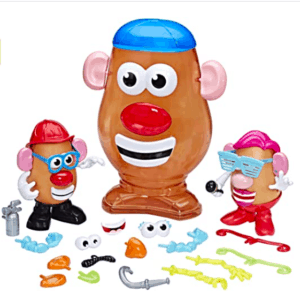
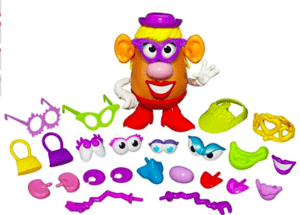
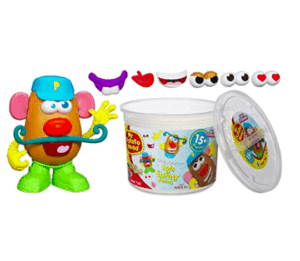
Star Wars Spuds!



Toy Story

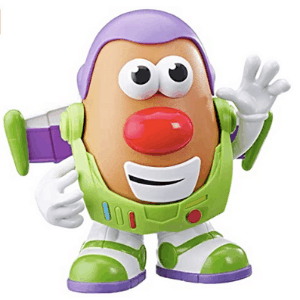

Marvel Heros
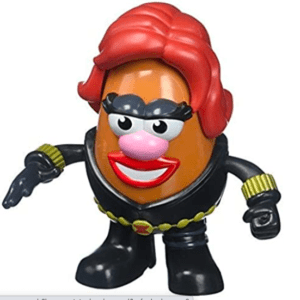
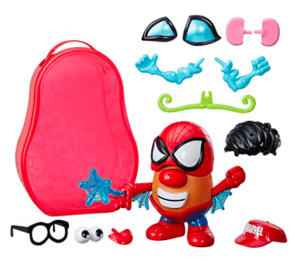
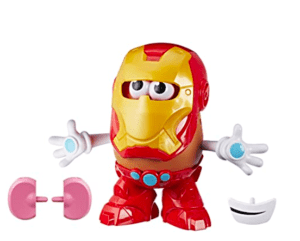
ThinkSLP
You’ve heard all about my SLP-love-affair with the spud-stud Mr Potato Head: let me know in the comments what you think of this SLP super toy.

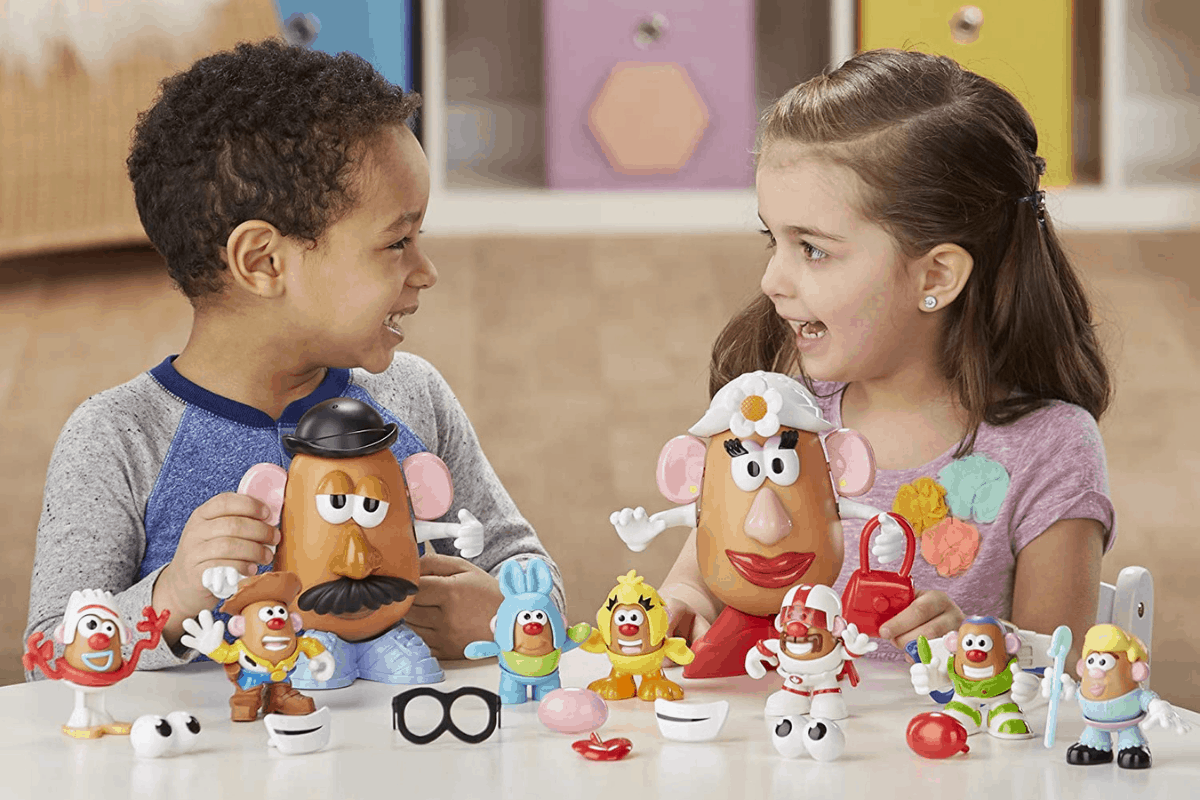
1 thought on “Mr. Potato Head: An SLP Super Toy”